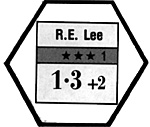 Lee Invades the North poses very different problems to each
side. Players must learn to utilize all their side's positive features, while
denying the opponent his. Union infantry units represent corps, with
cavalry present as brigades in the 1862 scenarios and divisions in the
1863 games. McClellan commands the Union army in both 1862
campaigns, while Hooker commands the army until partway through
the first 1863 scenario, then Meade commands. Pleasonton commands
the Union cavalry throughout the two invasions. Confederate infantry
units represent divisions, with Stuart's, cavalry in brigades. Lee and
Stuart command their respective forces in all scenarios. The South has
an added bonus by having corps leaders, two in 1862 and three in 1863.
This reflects the South's more flexible command structure and
outstanding leaders.
Lee Invades the North poses very different problems to each
side. Players must learn to utilize all their side's positive features, while
denying the opponent his. Union infantry units represent corps, with
cavalry present as brigades in the 1862 scenarios and divisions in the
1863 games. McClellan commands the Union army in both 1862
campaigns, while Hooker commands the army until partway through
the first 1863 scenario, then Meade commands. Pleasonton commands
the Union cavalry throughout the two invasions. Confederate infantry
units represent divisions, with Stuart's, cavalry in brigades. Lee and
Stuart command their respective forces in all scenarios. The South has
an added bonus by having corps leaders, two in 1862 and three in 1863.
This reflects the South's more flexible command structure and
outstanding leaders.
Players are given a record sheet, providing the setup for each scenario. All units have their initial strengths recorded on these sheets. These strengths can increase or decrease as the scenario is played. Losses can come from attrition (in 1862), combat, or force marching, the latter being subject to a die roll.
Leaders are given three numerical ratings. The first is the leader's command rating, used to determine the unit's movement allowance. The lower the rating, the better the leader. The second rating is the leader's initiative level, affecting force marching, reaction movement, morale recovery, and exiting enemy-occupied hexes. The last rating is the leader's combat bonus, which affects combat die rolls. The greater the number, the better the leader, in this case. In case two leaders are stacked together, the one with the highest rank commands, regardless of his ratings.
The South's greatest asset is its leaders. Due to their command ratings, mobility is rarely a problem for Lee's generals, and the South must exploit this if it is to win. The North, on the other hand, has a rather lethargic army, pushing its way toward the invaders. The North does have the advantage of operating in friendly territory, with use of railroad movement ensuring speedy transportation of troops and supply to threatened sectors.
Lee Invades the North has four scenarios, two covering the Maryland campaign of 1862 and two covering the Gettysburg campaign in 1863. All four scenarios place the players in the situation their historical counterparts found themselves in at that time, although the Union initial setup for Scenario One allows a certain amount of flexibility.
Lee Invades the North Players' Notes
- Introduction
Scenario One - Frederick to Antietam
Scenario Two - The Maryland Campaign
Scenario Three - The Pennsylvania Campaign
Scenario Four - Collision at Gettysburg
Tactical Notes
Scenario One Report: Jumbo Map (slow: 106K)
Back to Table of Contents: CounterAttack # 2
To CounterAttack List of Issues
To MagWeb Master Magazine List
© Copyright 1988 by Pacific Rim Publishing Company.
This article appears in MagWeb (Magazine Web) on the Internet World Wide Web.
Other articles from military history and related magazines are available at http://www.magweb.com